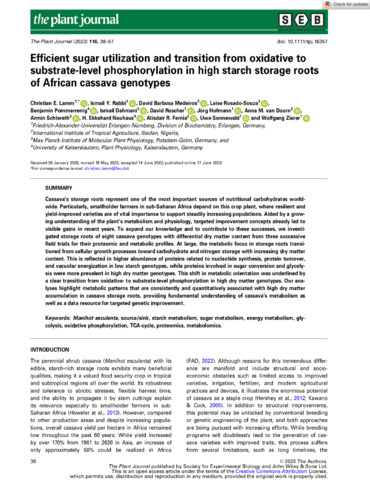Efficient sugar utilization and transition from oxidative to substrate-level phosphorylation in high starch storage roots of African cassava genotypes
Abstract
Cassava's storage roots represent one of the most important sources of nutritional carbohydrates worldwide. Particularly, smallholder farmers in sub-Saharan Africa depend on this crop plant, where resilient and yield-improved varieties are of vital importance to support steadily increasing populations. Aided by a growing understanding of the plant's metabolism and physiology, targeted improvement concepts already led to visible gains in recent years. To expand our knowledge and to contribute to these successes, we investigated storage roots of eight cassava genotypes with differential dry matter content from three successive field trials for their proteomic and metabolic profiles. At large, the metabolic focus in storage roots transitioned from cellular growth processes toward carbohydrate and nitrogen storage with increasing dry matter content. This is reflected in higher abundance of proteins related to nucleotide synthesis, protein turnover, and vacuolar energization in low starch genotypes, while proteins involved in sugar conversion and glycolysis were more prevalent in high dry matter genotypes. This shift in metabolic orientation was underlined by a clear transition from oxidative- to substrate-level phosphorylation in high dry matter genotypes. Our analyses highlight metabolic patterns that are consistently and quantitatively associated with high dry matter accumulation in cassava storage roots, providing fundamental understanding of cassava's metabolism as well as a data resource for targeted genetic improvement.

